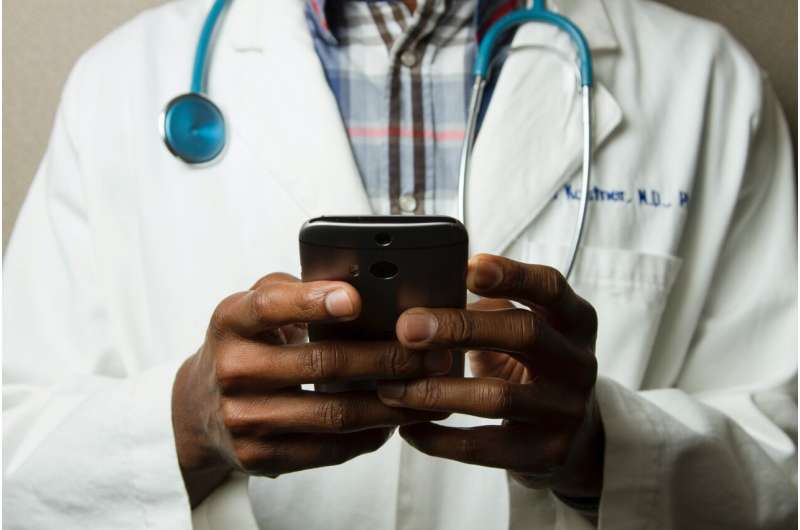Telehealth is a valuable option in cardiovascular care, though challenges remain

Telehealth is a proven and valuable option for people with cardiovascular disease; however, there are limitations to its use in rural and under-resourced communities, according to a new scientific statement from the American Heart Association, published today in the journal Circulation. An American Heart Association scientific statement is an expert analysis of current research and may inform future treatment guidelines.
Telehealth enables remote delivery of health care through technologies, such as structured telephone or video support and remote monitoring of wearable or implantable devices. This kind of technology-driven health care delivery grew tremendously during the COVID-19 pandemic, with up to 30% of all U.S. clinic visits conducted via telehealth in mid-2020—showing interest in and capability of telehealth as a substitute for face-to-face patient care. However, data has shown its use has slowly declined as COVID-19 restrictions eased in late 2021.
"Telehealth is transforming the way health care is delivered by improving convenience and availability," said the statement's lead author Edwin A. Takahashi, M.D., an assistant professor of radiology in the division of interventional radiology at the Mayo Clinic College of Medicine in Rochester, Minnesota. "However, we learned during the pandemic when we were forced to limit in-person care that there are limitations to using telehealth."
This new scientific statement, "An Overview of Telehealth in the Management of Cardiovascular Disease," highlights the impact of telehealth in heart disease, stroke and peripheral artery disease (PAD) management, reviews strategies and obstacles for telehealth adoption in cardiovascular disease (CVD) care and identifies knowledge gaps.
The benefits of telehealth for CVD
The writing group's review found that telehealth may:
- reduce health care costs;
- improve access to care in rural and underserved areas; and
- increase care quality and patient satisfaction.
These benefits are especially important for people with CVD, which disproportionately affects people from underrepresented racial and ethnic groups who often have additional barriers to health care and those with less access to medical care.
Telehealth portals and smart devices may be cost-effective options for remotely managing conditions that are cardiac risk factors, such as high blood pressure and diseases like heart failure and coronary artery disease. "Telestroke," the most studied area of telehealth in CVD, which is highly specialized stroke care delivered by first responders receiving instructions and guidance from remote stroke experts, often leads to improved rehabilitation and recovery for people who have had a stroke or may otherwise lack access to specialized stroke care.
The challenges of using telehealth
Challenges that may prevent more widespread telehealth use in CVD include barriers for both health care professionals and their patients.
For health care professionals, the challenges identified are:
- acceptance and uptake of telehealth technology, which may vary because of health care professionals' age, technology expertise and perceptions;
- inconsistent reimbursement and licensing matters (license requirements vary by state);
- logistical challenges in scheduling and maintaining workflow; and
- lack of infrastructure to analyze data from remotely monitored devices.
Privacy and security are also key factors for professionals to consider. "Even though most telehealth platforms are highly encrypted," Takahashi said, "they are not fully secure and may be at risk for data breaches."
For people with CVD, the challenges identified are:
- limited resources to access technology and devices for older adults and under-resourced populations;
- health literacy barriers, including cultural and language barriers that may prevent people from using digital platforms, consumer wearables and other devices to their full capacity; and
- insufficient access to internet bandwidth for a high-quality video appointment.
The statement asserts that the infrastructure for broadband internet must be improved, especially in rural areas that lack direct access to medical care, creating a "medical desert."
Strategies to overcome obstacles
Infrastructure, technology and reimbursement are the key areas to address barriers to telehealth use. For the approximately 25% of U.S. adults without broadband access, the statement suggests public policy changes may be helpful to supplement efforts by the private sector to expand affordability and access to internet services. An appraisal of current policy and identifying potential targets for policy reform are necessary, according to the writing group.
As the country shifts back to in-person care, the statement encourages research into the role of telehealth beyond the pandemic. "Telehealth has the potential to have a larger role in urgent diagnosis and remote monitoring," Takahashi said.
However, reimbursement challenges need to be addressed, and simplified, as well. Not all insurance payers reimburse equally for in-person vs. telephone vs. video appointments, which ultimately lowers reimbursement for professionals who care for patients without video capability. And, as telehealth expands, there is a need for standards in how to assess the quality of telehealth care provided.
"Telehealth will play an important role in the future of cardiovascular care because the evolution of technology will enable new remote care opportunities to improve medical accessibility," Takahashi said. "Hopefully, this will have a strong benefit for patients from historically excluded and rural communities who often face health care disparities and are most at risk for cardiovascular diseases."
More information: Edwin A. Takahashi et al, An Overview of Telehealth in the Management of Cardiovascular Disease: A Scientific Statement From the American Heart Association, Circulation (2022). DOI: 10.1161/CIR.0000000000001107




















